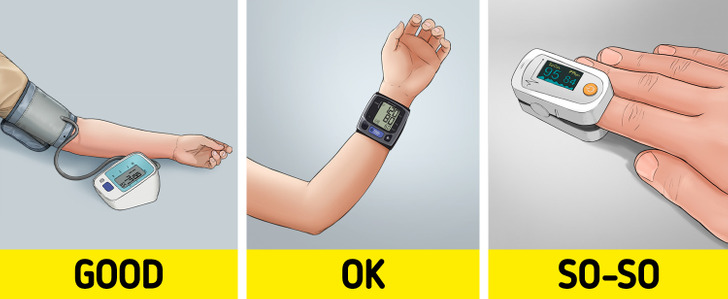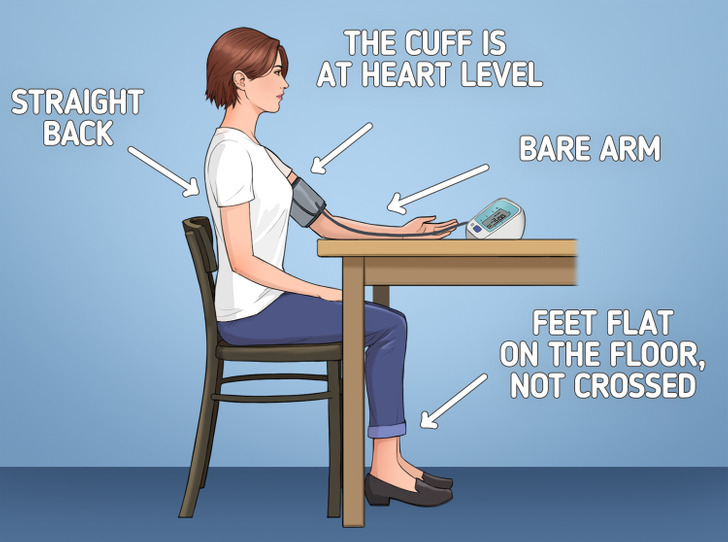How to Take Blood Pressure Correctly
Blood pressure is the pressure caused by the blood circulating through the body on the walls of the blood vessels. Along with body temperature, respiratory rate, and heart rate, it is one of the most important indicators that medical workers use to assess a person’s health.
In order to get true numbers, it’s important to take blood pressure regularly. 5-Minute Crafts is telling you what nuances should be kept in mind when measuring blood pressure.
❗ This article is for information purposes only and doesn’t replace professional advice.
Where, when, and which device it’s better to use for measuring blood pressure

Where:
The most suitable place for taking your blood pressure is the upper part of the right or left arm. Some devices can also be attached to the wrist or the tip of a finger. In exceptional cases, blood pressure can be measured from the thigh or calf.
❗ Although pressure can be measured on both the left and right arms — for some people, readings on different arms can vary significantly. Find out which arm usually gives higher readings and use it afterward.
When:
In order to get the most precise readings about your blood pressure, experts recommend measuring it daily at the same time or even several times a day, like in the morning and the evening, for example.
Which device:
Digital devices for measuring blood pressure on the upper arm are considered to be the most precise. Devices that are attached to the wrist may give distorted results due to the position of the hand during the procedure. For the readings to be accurate, the arm must be on the table at the level of the heart. If it turns out to be slightly raised or lowered, the results can be considered invalid.
Blood pressure in the upper limbs can differ from the pressure in the whole body, so devices that measure pressure at the fingertips are considered the least accurate.
Before measuring blood pressure
Many people think that one can measure blood pressure at any time and without special preparation. But it’s wrong. Some actions such as physical exercises can temporarily affect the rise of blood pressure.
To measure blood pressure correctly, take into account the following nuances:
- Avoid drinking caffeinated drinks at least 30 minutes before your procedure.
- Empty the bladder and ensure 5 minutes of quiet rest.
- If you are measuring blood pressure in the morning, try to do it before breakfast and before taking any medications.
- If you monitor blood pressure in the evening, measure it before taking a bath or taking medication.
- Use a cuff of a suitable size. People with big arms may require big cuffs. Those who have thin arms will require a special lower bracket to have accurate readings of their blood pressure.
Failure to comply with these nuances can lead to erroneous indicators and can greatly distort the idea of your health condition.
How to take blood pressure correctly

- Sit on a chair in front of a table. Keep your back straight, place your feet on the floor, and don’t cross them.
- Spend about 5 minutes in a calm condition. Try to relax. Don’t talk while making measurements.
- Put your arm on the table (or another flat surface) so that the upper arm is located at the heart level. Only the part of the arm where the cuff is fastened should be located at the heart level.
- In order to bare your arm, remove the clothes or roll up the sleeves. Put the cuff on your arm.
❗ Do not place the cuff over clothing. If the rolled-up sleeve squeezes the muscles, it is better to completely free your hand. - Make sure the lower part of the cuff is located right over the elbow bend.
For an automatic blood pressure monitor:
Turn the device on and measure blood pressure. Follow the instructions to make sure you do everything correctly.
For a manual blood pressure device:
- Put the stethoscope into your ears. Find the brachial artery just below the cubital fossa by palpation and put the stethoscope diaphragm upon this.
- With the help of the stethoscope ear attached to the cuff, start inflating the cuff. At some point, you’ll hear pulsation resembling a heartbeat. Keep inflating the cuff until the pulsation disappears.
- Start to slowly release the air with the help of the side valve on the stethoscope ear. Note the moment when the pulsation appears again, and remember the number that the arrow was pointing to at that moment. This reading is your upper (systolic) pressure.
- Continue gradually releasing the air. When you stop hearing the pulse, look again at the value the device is showing. This will be your lower (diastolic) pressure.
- Take your blood pressure again after a couple of minutes. If the readings are different for more than 5 points, make the 3rd final check.